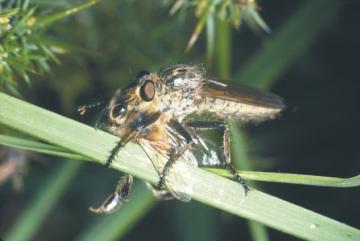Species Account for Eutolmus rufibarbis
Eutolmus rufibarbis (Meigen, 1820)
Diptera: Larger Brachycera: Asilidae

Reproduction for study and non-profit use permitted, all other rights reserved.
Taxonomic group: soldier flies and allies (Diptera: Larger Brachycera) - County data
View time series maps for Eutolmus rufibarbis
member log-on for taxon report
Status: NS
Essex RDB: Listed
Threat: Essex Endangered
Images
upload a new image
Species text
The large robber fly Eutolmus rufibarbis is a rare southern species with strongholds in the Breck districts of East Anglia and the heaths of Surrey and West Sussex. Falk (1991a) states that there are only 20 known post 1960 sites, mainly within the Brecks and West Sussex Heaths, with only two recent records for Surrey. In Essex the only record was of a single female found in 1994 on the southwestern edge of Mill Wood, where it was probably looking for an ovipositation site. There is an old (pre-1970) record shown in Drake (1991) for north Kent at TQ56, suggesting that a population may have been present in the region, at least in the past. Shirt (1987) notes that the species is confined to large blocks of open dry heathland, an especially vulnerable habitat. Adults are predatory upon other insects and the eggs are apparently laid within incisions cut by the female ovipositor in herbage, though larval development probably occurs in sandy soil. In 1994 there were extensive sandy grasslands across much of the Mill Wood Pit area, providing both hunting and nesting habitat. However the area was virtually all developed for housing and the amount of suitable habitat present both in Chafford Hundred and elsewhere in the region was thought to too small to support this species, which was assumed to be extinct in the county. Remarkably, in 2014 a male and female were found in almost the same location as the first 1994 female, so it seems that a small population has hung on in the small habitat area remaining. References
Habitats
Recorded management for locations with Eutolmus rufibarbis
Recorded substrate and hydrology for locations with Eutolmus rufibarbis
Why not join the Club, register and add a new species page
Interpretation of distribution maps



















